Our guide will help you gain a better understanding of how telehealth is helping improve medication management and deliver other noteworthy patient care benefits. Read the guide below or enter your email to download your copy to take on the go.
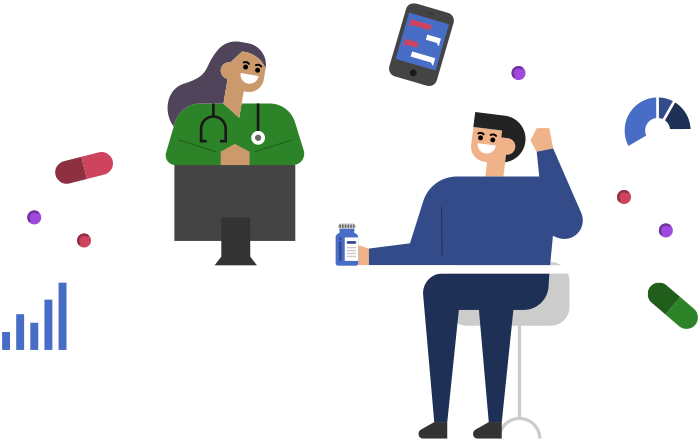
One of the silver linings of the COVID-19 pandemic is the emergence of telehealth. Its usage was slowly on the rise leading into 2020, but to say the health crisis accelerated adoption would be an understatement. As Health Affairs noted,
“Before the public health emergency, approximately 13,000 beneficiaries in fee-for-service Medicare received telemedicine in a week. In the last week of April 2020, nearly 1.7 million beneficiaries received telehealth services.”
While one would expect that these services will fall off a bit following the health crisis and return of some restrictions that were eased to expedite expanded access to telehealth, it is apparent that telehealth will be sticking around — and in a big way. As Health Affairs further noted,
“During these unprecedented times, telemedicine has proven to be a lifeline for healthcare providers and patients. The rapid adoption of telemedicine among providers and patients has shown that telehealth is here to stay.”
Telehealth is providing a wide range of valuable services to patients in rural and urban settings. This includes helping with medication management. And that’s welcomed news considering the well-documented challenges associated with medication adherence that lead to patient harm, poor outcomes, readmissions, and increased use of healthcare services. Within telehealth, the discipline of telepharmacy is taking on greater importance, with telepharmacists delivering a wide range of medication-related services that are ultimately helping patients get the medications they need, when they need them, while also supporting efforts to improve adherence.
This e-book examines a wide range of issues concerning telehealth and telepharmacy, including the rapidly expanding role of telehealth; how telehealth — and, within it, telepharmacy — is helping improve medication management and deliver other noteworthy patient care benefits; and the ways that the pandemic has reshaped how we think about telehealth and its potential to bridge gaps in healthcare delivery.
By leveraging the insight, guidance, and resources within this e-book, you will be in a better position to maximize the benefits of telehealth for your organization and its patients and enhance the performance of your medication management program. The results: more personalized care and enhanced patient engagement that will lower your costs.

When it comes to understanding telehealth and its various services and subsets, it’s key to first make sure you have a firm grasp of the definitions of relevant terms. There’s a lot of confusion surrounding them, so let’s take a look at the definitions that matter most.
Telehealth is a broad term used to describe the delivery of healthcare services using telecommunications technologies. The American Telemedicine Association, Federation of State Medical Boards, Centers for Medicare & Medicaid Services (CMS), and individual states all have varying definitions, many of which take into consideration coverage and reimbursement specifics. But generally speaking, telehealth is a way of delivering care that enables providers to treat or counsel patients without the two having to be in the same location.
Telehealth services are delivered using a number of platforms and devices, and they can be performed in several ways:
Synchronous, often using live video
Asynchronous, through the transmission of information using an electronic communications system
Collecting a patient’s clinical indicators and data using an implanted or manual reporting technology and responding or acting on the data
Within the broad category of telehealth there are many subsets, including the following:
The remote delivery of medical services by a physician or non-physician provider
The remote delivery of medication counseling or management by a pharmacist or pharmacy technician
Telehealth can be performed in a variety of different location types — from a patient’s home or workplace to a rural hospital or school. And the number of services that can be delivered via telehealth is fairly extensive and includes treating minor colds, managing chronic diseases, post-operative care, and medication management, just to name a few.
A common mistake is to use the terms “telemedicine” and “telehealth” interchangeably. Even though they are alike in many ways, there are noteworthy distinctions. Clinicians must understand these so they can effectively address how telemedicine and telehealth can play a role in improving patient care.
The Federal Communications Commission (FCC) defines telemedicine as “… using telecommunications technologies to support the delivery of all kinds of medical, diagnostic, and treatment-related services, usually by doctors.” The American Academy of Family Physicians (AAFP) defines telemedicine as “… the practice of medicine using technology to deliver care at a distance.”
The FCC states that telehealth is similar to telemedicine but “… includes a wider variety of remote healthcare services beyond the doctor-patient relationship.” AAFP states telehealth “… refers broadly to electronic and telecommunications technologies and services used to provide care and services at-a-distance.”
Let’s look at examples of the two to further delineate:
 A 2018 American Medical Association survey showed that radiology has the highest use of telemedicine for patient interactions than any other medical specialty, reports Health Imaging. A Health Progress article describes “teleradiology” as follows: “… a CT is sent securely over the Internet, a report is generated, and the treating physician gets a message. During a standard telemedicine encounter, a remote physician is notified that a patient is in the queue. The physician then reviews patient information from the electronic medical record, visits with the patient over phone or video, documents his or her findings, and communicates recommendations to the requesting physician. Except for minor differences based on specialty and video availability, the infrastructure is the same.”
A 2018 American Medical Association survey showed that radiology has the highest use of telemedicine for patient interactions than any other medical specialty, reports Health Imaging. A Health Progress article describes “teleradiology” as follows: “… a CT is sent securely over the Internet, a report is generated, and the treating physician gets a message. During a standard telemedicine encounter, a remote physician is notified that a patient is in the queue. The physician then reviews patient information from the electronic medical record, visits with the patient over phone or video, documents his or her findings, and communicates recommendations to the requesting physician. Except for minor differences based on specialty and video availability, the infrastructure is the same.”
Telehealth nursing is another function that’s expanding, according to a Nursing2019 article. The article notes that telehealth nursing is a “… tool for delivering nursing care remotely to improve efficiency and patient access to healthcare.” Telehealth nursing services include the ability to “… guide patients to emergency department visits, clarify appropriate treatment options, educate about self-care at home, and assist with appointment scheduling.”
For additional examples, you can read about them here.
According to AAFP: “Telehealth is different from telemedicine in that it refers to a broader scope of remote healthcare services than telemedicine. Telemedicine refers specifically to remote clinical services, while telehealth can refer to remote non-clinical services.” CCHP further elaborates: “Telemedicine is often still used when referring to traditional clinical diagnosis and monitoring that is delivered by technology. However, the term telehealth is now more commonly used as it describes the wide range of diagnosis and management, education, and other related healthcare fields.”
In sum, telehealth is broader than telemedicine, while telemedicine refers exclusively to clinical services. To understand more, it helps to examine different delivery models of telemedicine.
Keep in mind that there are two main options for delivering telemedicine: synchronous and asynchronous. It’s crucial to grasp how these forms of telemedicine differ to achieve the goals of your telemedicine program.
The Office of the National Coordinator for Health Information Technology (ONC) defines synchronous telemedicine as “live video-conferencing,” which is a “two-way audiovisual link between a patient and a care provider.” A Healthcare Informatics Research (HIR) article states, “The major advantage of a synchronous approach is the efficiencies gained by having the opportunity to refine details pertinent to the care episode during the session, by seeking additional information or data, and in many cases providing a clinical decision or advice within the session.” Other advantages include timely care, the preservation of the face-to-face doctor patient relationship, convenience, and access. Additionally, The Online Journal of Issues in Nursing states that:
“Synchronous visits enable assessment, diagnosis, and treatment in hospital or clinic settings, and facilitate nurse-to patient-education.”
“Critical access hospitals with limited resources can benefit from prompt, synchronous consultation by a neurologist, in the event a stroke is clinically suspected, and timely treatment with thrombolysis is critical.”
In contrast, asynchronous telemedicine does not occur on a “live basis.” ONC defines it as “store-and-forward video-conferencing,” which is the “transmission of a recorded health history to a health practitioner, usually a specialist.” In other words, synchronous systems “… decouple the components of the interaction so that they can occur at different times at the convenience of the participating parties,” according to the HIR article.
CCHP shares several asynchronous telemedicine benefits, including the following:
“Patients can get timely specialty care without needing to travel beyond the location of their primary care providers.”“
Wait times for specialty care are lessened, especially in areas with shortages of medical specialists.”
“The store-and-forward process can overcome language and cultural barriers.”
Additionally, an mHealth Intelligence article notes, “… proponents of store-and-forward technology say the platform is ideal for evidence-based care in which providers are able to gather all the information on a patient, analyze that data, match it to evidence-based care, and make a diagnosis. While perhaps not suitable for emergency care, it gives providers the leeway to add clinical decision support to the process and eliminates the sometimes-inconvenient requirement of having both patient and doctor available at the same time.”
Regardless of which option is chosen, organizations must consider how to make their delivery systems effective.
Let’s suppose you are ready to implement a telemedicine program. One of your biggest considerations will be how to do so. The two most common ways to deliver a telemedicine visit are live video conferencing and remote patient monitoring.
Live video visits involve a patient and a physician or non-physician provider having a HIPAA-compliant conversation via video conference software on a computer screen or mobile device. For a better understanding of how this works, watch this two and a half minute video from Johns Hopkins that shows how physician-patient video visits work in that organization, who is involved, and the value they bring for patients and physicians.
Prior to offering video visits, organizations routinely ask patients to sign a consent form and book the video visits in the same appointment schedule used for in-person visits. Most providers block time for video visits so they are not shuffling back and forth from their laptop to the exam room.
Another consideration is the placement of equipment. Specialists who use connected devices, such as a digital spirometer or otoscope, to conduct virtual exams often dedicate a room for their telemedicine visits, so the equipment stays in one place.
The array of technology platforms that can be used to conduct video visits is vast, and so are the features they offer. Some platform vendors offer only the software, which can be purchased as a subscription or via license fee. Other vendors offer their platform plus a service option. For instance, if a primary care group wants around-the-clock telemedicine visit coverage, it can contract with the telemedicine technology company’s clinical team, which is available to the practice’s patients after regular clinic hours.
When evaluating your options, ensure the provider’s documentation meets the same criteria as an in-person visit and that it makes its way back into the medical record. It’s best if a telemedicine module is integrated with an organization’s electronic health record (EHR), but that does not always need to be the case.
In addition to examining your method of delivery, it pays (literally) to consider reimbursement requirements as you design your program.
Reimbursement for telehealth and telemedicine visits is not uniform. It can differ drastically according to state and payor. Most commercial payors reimburse for these visits, but the rules vary from one payor to the next, so it’s imperative that coding, billing, and business office teams know the details for their specific payors. The best counsel for any physician organization considering telemedicine visits is to be on top of billing and payor rules before scheduling the first patient. A firm grasp of the coverage rules will allow you to know how to bill the visits to payors and anticipate the portion you should appropriately collect from patients.
Over the last few years, dozens of states have introduced hundreds of telemedicine bills. Even if your state does not have a parity law today, it may in the near future. Research your state’s Medicaid rules as well. Although nearly all Medicaid programs reimburse for telehealth, what is covered varies state to state.
While there is no standardized definition for mHealth, we can gain a better understanding of the term and what it encompasses by looking at some widely cited and recognized definitions. The book “M-health: Emerging Mobile Health Systems” defines mHealth as an “emerging mobile communications and network technologies for healthcare systems.”
Remote patient monitoring is a subcategory of home care and telehealth that enables patients to use mobile devices and mobile health technology to gather, enter, or automatically collect health data and transmit it to healthcare providers. The ability to track patient conditions in between visits, and notify a clinician or care manager when the patient’s biological data is putting the patient at risk, is a giant improvement in managing care. Without mobile devices and mobile health technology, like wearable devices such as watches, fitness trackers, and wristbands, continuous tracking and monitoring of such data would not even be possible — and certainly be inconvenient.
Remote patient monitoring is one example of mHealth. Scientist and professor Robert Istepanian is credited with having coined and defined the concept of “mHealth” (i.e., mobile health) in 2003. Just eight years later, in her speech at the mHealth Summit, Kathleen Sebelius, U.S. Health and Human Services secretary at the time, said, “When we talk about mobile health, we are talking about taking the biggest technology breakthrough of our time … And while we have a way to go, we can already imagine a remarkable future in which control over your health is always within hand’s reach.”
The Global Observatory for eHealth of the World Health Organization defines mHealth as
“medical and public health practice supported by mobile devices, such as mobile phones, patient monitoring devices, personal digital assistants, and other wireless devices.”
Here are some other examples of mHealth technology and how they aim to enhance the delivery of patient care:
As a National Institute of Health (NIH) fact sheet notes, point-of-care diagnostic testing
“… allows patient diagnoses in the physician’s office, an ambulance, the home, the field, or in the hospital. The results of care are timely and allow rapid treatment to the patient.”
An example of mHealth starting to gain significant traction in its adoption is mobile medication management, discussed in more detail in Chapter 4.
An emerging application for mHealth, this is in the promising field of medical imaging. As smartphone technology has seen significant improvements in recent years (e.g., image quality, camera capabilities, speed, data transfer), companies can use these more powerful devices to transform imaging.
With all of these opportunities for application, it’s easy to grasp why mHealth and telehealth are on the rise, but what else is driving the adoption rates up? Let’s examine the factors that play a role.
The increase in the use of telehealth by healthcare systems and provider organizations over the last several years — and dramatic surge that occurred in 2020 — can be traced to the fusion of six key forces, which we will explore in depth throughout this guide:

Lower Technology Costs – New, lower-cost platforms and solution providers have popped up over the last few years, such as AmWell, Vidyo, Doctor on Demand, Carenet Health, and MDLive. Today, no special equipment is required to furnish and receive telehealth. Most providers and patients use mobile devices and tablets, removing the previous need for specialized — and often expensive — equipment.


State Approvals of Telehealth – There has been sweeping change in favor of telehealth at the state level over the past several years. Since state boards of medicine and legislatures have recognized the benefits of improved access, better care, and reduced costs, they have changed their laws.


New Codes and Reimbursement Changes – When state legislatures and boards of medicine began embracing telehealth, coverage and reimbursement requirements became precise and easier to decipher. In 2018, CMS implemented new codes and telehealth coverage. And in 2019, the agency implemented new codes and incentives for remote patient monitoring. In 2020, CMS significantly — albeit temporarily — expanded the list of covered telehealth services that can be provided to Medicare beneficiaries.


Proven Care Improvement and Cost Reduction – The resulting cost savings from telehealth has been a game changer for many organizations. Here is an example: Patients enrolled in the telemedicine program at Geisinger Health experienced 44% lower readmissions over 30 days and 38% lower over 90 days, compared to those not enrolled in the program.


Patient Satisfaction – It’s now widely acknowledged that patients appreciate the convenience of telehealth options. Patient satisfaction data is abundant, but here’s one stat from a recent Massachusetts General Hospital study: 68% of patients rated telehealth visits a nine or ten on a ten-point scale.


COVID-19 Pandemic – The final force in this list may be the most significant. Within just weeks of the declaration of the pandemic, practices shifted from furnishing almost no virtual visits to only providing such visits while hospitals that may have conducted a few hundred virtual visits in all of 2019 were surpassing that figure in just a few days. As FAIR Health reported, telehealth claim lines increased more than 4,000% nationally from June 2019 to June 2020. Thanks to the novel coronavirus, telehealth achieved growth in adoption that would have taken years in only a matter of days.

As you can see, the benefits of telehealth, telemedicine, and mHealth to patients and providers seems promising, and usage is unquestionably on the rise. Now that we’ve established a framework for understanding the terminology of each service, let’s take a closer look at the applications.
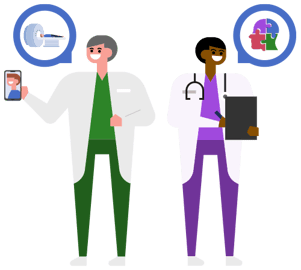
Telehealth adoption is growing — but not evenly across all specialties. Most discussions about telehealth focus on its applications for primary and acute care providers. But if we left the conversation at that, we would overlook some new and exciting ways that medical specialists are employing telehealth.
Radiology, psychiatry, and cardiology are three specialties leading the use of telehealth with patients. However, the majority of specialists have been slow to adopt telehealth and telemedicine in their practices.
Radiologists were early adopters of store-and-forward telehealth technology, primarily because these physicians must review and report on images such as X-ray, ultrasound, and CT scans. Given the high-tech nature of their specialty, cardiologists were also some of the first specialists to use remote patient monitoring to review patient biometric data streaming from implanted and wearable devices.
Despite these use cases, the majority of specialties have been slow to integrate telehealth into practice. Here are some ways that telehealth could be used in specialties to improve patient convenience, follow up, medication management, and condition monitoring:
According to AMA research published in Health Affairs, 28% of psychiatrists use telehealth (a figure that has certainly increased during the pandemic), but that still leaves a lot of opportunity for patients who need to be seen and have their medications managed virtually. The fact that rural areas have the highest rates of suicide and the fewest numbers of mental health resources, telemedicine in these specialties could quite literally be a lifesaver for many.
Guidance concerning pregnancy, management of gestational diabetes, preeclampsia, pre- and postpartum nutrition, weight loss, and breastfeeding can all be handled using a video visit, Consider how practical this could be as opposed to requiring mothers to show up at the doctor’s office throughout their pregnancy and postpartum care.
Imagine the increased opportunity to treat menopause symptoms, educate women about hormone replacement therapy options, and support patients through life transitions, menopausal stress management, depression, and insomnia. Many of these issues go untreated or are handled by primary care physicians, who are often not as adept in this area
According to Amwell, 88% of patients with existing neurological conditions prefer follow-up by video, and studies show that telehealth offers promising remote care for patients with epilepsy, ALS, and other neurological conditions.
There are so many commonplace childhood ailments such as pink eye, rashes, ear pain, and sore throat that can be handled by a video visit and an e-prescription to the pharmacy. Most often, midlevel providers and well-trained nurses and nurse practitioners can manage these telehealth visits.
For these patients, post-op care is a priority. Several orthopedic surgeons and departments have been successful at offering telehealth for routine post-op wound checks and care. Given that most orthopedic surgeons’ appointment schedules are very busy, telehealth visits can aid in reducing post-op visits. This can help open up slots for patients who truly need to be seen in the office.
IEnabling a surgeon to consult with coaches and athletic trainers about on-the-field injuries can reduce unneeded visits to the emergency department. This is just one example of how powerful telehealth can be in orthopedics for sports medicine.
Benefits for this specialty include timely diagnosis and treatment plan recommendation, continuity of care, and support for local physician management. As the University of Pittsburgh Medical Center’s notes, “These teleopthalmology 17 | Telehealth and Medication Management: A Comprehensive Guide services can be invaluable for patients who live in regions where local hospitals do not employ ophthalmologists.”
The value of teleurology is highlighted in the American Urological Association’s (AUA) white paper “Telemedicine in Urology.” As the paper states, “An impressive array of urologic telemedicine services have been successfully implemented … Urologists have been pioneers in the use of telemedicine, particularly in the areas of telerobotic surgery, teleproctoring, telementoring, and telerounding.”
Considering we’re in the midst of an opioid epidemic, it’s encouraging to examine the implications of telehealth to aid patients and pain management providers. One example was profiled in a mHealthIntelligence.com article. Relievus Pain Management, based in Cherry Hill, N.J., added a telemedicine platform in mid-2018 that allows its providers to monitor patients at home and adjust care plans. In addition to tracking pain, the platform also helps with examining a patient’s mental wellbeing.
In sum, telehealth has already begun to spread beyond acute and primary care. When the technology is leveraged effectively, it can deliver significant value to specialty telehealth services. As more specialties begin to join the telehealth sphere, they will increasingly rely on telepharmacy as well.
Learn five things to know about medication compliance, including why it is a subject that some healthcare professionals argue is no longer deserving of attention.
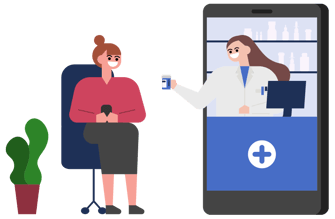
We would be remiss if we didn’t mention the impact of telehealth on the pharmacists who serve those patients receiving care from specialty providers. The American Society of Hospital Pharmacists defines telepharmacy as “a method used in pharmacy practice in which a pharmacist utilizes telecommunications technology to oversee aspects of pharmacy operations or provide patient care services. Telepharmacy operations and services may include, but are not limited to, drug review and monitoring, dispensing, sterile and nonsterile compounding verification, medication therapy management (MTM), patient assessment, patient counseling, clinical consultation, outcomes assessment, decision support, and drug information. Telepharmacy also enables comprehensive medication management (CMM), which will be discussed in greater depth in chapter four of this eBook.
Telepharmacy is transforming the current way we manage medications by enabling organizations to “bring in” pharmacists to deliver services such as medication treatment plan assessment, medication reconciliation, patient education, and adherence counseling. Asa bonus, telepharmacy solutions allow clinical pharmacists to follow up with patients more frequently and efficiently than would be possible in a traditional healthcare workflow.
Another reason telepharmacy is so appealing is the amount of time it saves for medical staff. Consider these scenarios: A physician accessing a pharmacist on an iPad so the pharmacist can provide patient education and medication review during a patient’s visit to the clinic. Or a pharmacist conducting a hospital beside visit on a computer screen, reviewing medication orders with the patient and providing transition-of-care instructions about discharge medications.
With telepharmacy, there’s no more waiting for the pharmacist to make rounds from floor to floor. When the pharmacist can “visit” with more patients from a screen, they are more efficient with time.This removes these tasks from the to-do-lists of nurses and physicians, allowing them more time to work at the top of their licensure.
And here’s another way telepharmacy can transform workflow: A remote pharmacist can deliver focused follow up with patients after they’ve seen their physician or in the post-acute care period — and do so more often than if they needed to drive to a facility. Such medication reconciliation postdischarge (MRP) is critical (we discuss MRP further later in this chapter). During these encounters, pharmacists can better ensure patients have picked up and are taking their medications properly, that dosages are correct and effective, and that adverse drug events and prescribing cascades that land patients back in the hospital or doctor’s office are minimized.
Inherent in CMM is the pharmacist’s ability to access the patient’s electronic health record (EHR) to review conditions, lab and test results, and progress notes. When these services are delivered by telepharmacy, it’s no different.
Another positive element of telepharmacy is how it can help mitigate some of the medical industry’s most vexing issues — in particular, problems associated with medication management. Here are some ways telepharmacy can contribute to solutions:
For entities performing prior authorization and refill authorizations, telepharmacy can take the form of a pharmacist working remotely with physician clinics and helping those clinics if they have collaborative practice agreements in place. This would permit pharmacists to authorize refills. If patients need electronic prior authorizations or other prior authorizations, pharmacists can help take care of some of those issues (doing so via a telepharmacy solution). In addition, telepharmacy assists with formulary compliance and helping ensure patients are on the most cost-effective alternative medications. Telepharmacy also provides the ability for pharmacists and prescribers to interact more with each other. Lastly, telepharmacy allows physicians to work more cost-effectively as well. For some physicians, it can be cost-prohibitive to hire a full-time pharmacist and embed them physically in their location.
These are areas where patients often struggle. Once patients are ready for discharge, counseling them to ensure they understand what medications they are supposed to be going home with on and what medications they should stop taking when they get home is critical. But they are often solely focused on getting home, which makes MRP an essential component in patient safety. Consider the benefits of following up via telepharmacy with the discharged patient within 24 to 48 hours. The goal is remove barriers for patients so that when they arrive home, they are on the right medications and not confused about their new regimen.
The bottom line here is that patients are more likely to comply with a regimen when they understand why they are taking medications. Adherence management is about ensuring that patients take their medications as prescribed, with an understanding of that “why.” Embracing telepharmacy that uses technology to identify and resolve adherence-related problems can be a major benefit to patients.
Telepharmacy counseling follows a similar philosophy as medication adherence: It’s a matter of ensuring patients understand the reason(s) they’re taking medications and addressing counseling issues that may have been overlooked when patients picked up medications or any other potential obstacles to regimen adherence.
One example of how pharmacists are leveraging telehealth is through the use of Meds 360°, Cureatr’s medication management platform. You can learn more about Meds 360° and how it assists pharmacists, clinicians, and organizations by watching this webinar.
Note: Some provider organizations lack the clinical pharmacy resources to adequately perform the telepharmacy applications described in this section. For those organizations, consider employing a telepharmacy service to manage these functions on your behalf remotely. Learn more about Cureatr’s telepharmacy services.
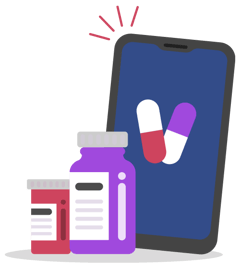
Another way that telehealth can make an impact is by helping with one of our nation’s most pressing problems: medication management. This is a problem costing substantly dollars and lives. The total cost of under-, over-, and misuse of medications has been estimated at $528 billion annually. Nothing to scoff at. If we look at how much money is spent in the United States for prescription use alone, it exceeds $450 billion. For every dollar spent on drug utilization, we’re spending $1.17 to reverse the unintended effects of those medications. As far as the return on investment for drug therapy in the United States, there are several areas of improvement that we must focus on.
More money is spent on medications and the reversal of those medications than we are spending on heart disease and cancer combined. These costs are realized through drug-related treatment failures and new medication problems. Even more distressing than the dollar amounts is the fact that these issues result in unplanned emergency department visits, hospital admissions, and longterm care admissions, ultimately resulting in roughly 275,000 deaths per year.
Furthermore, the United States is spending almost $530 billion a year on suboptimal medication management. These are related to drug therapy problems, such as adherence failure and new medical problems. More than about half of the events caused by suboptimal medication issues lead to physician visits and about one-third result in additional medications or prescriptions for those patients.
At first glance, it may not be immediately clear how telehealth can reverse some of these grim statistics, but once we examine the root cause, it becomes more evident.
Costs associated with suboptimal medication are caused primarily by the prescriber, not nonadherent patients. While adherence is important and worth focusing on as an area for potential improvement, analysis of available data indicates that costs are being driven more by suboptimal drug therapies. Examples include dose too high, dose too low, inappropriate medication or a wrong drug for a patient, or additional drug therapy needed.
If we look at that overall cost, $375 billion is being wasted due to suboptimal prescribing decisions, which is about 71% of that $528 billion. While the intent of prescribers is to “do no harm,” they often lack the information, resources, and the medication expertise necessary to adequately address problems in suboptimal medication management.
Non-adherence is about 15% of that $528 billion figure. While much focus is given to adherence, we can see that it is a fairly small piece of the problem and more attention needs to be given to ensuring the patient is on the correct therapy.
One way to address the root of the suboptimal medication management problem is through comprehensive medication management (CMM). CMM is guided by the principles that when a patient understands, agrees with, and is actively participating in their treatment regimen, this will lead to improved patient adherence, satisfaction, and ultimately clinical outcomes. CMM is defined as the standard of care that ensures each patient’s medications (e.g., prescriptions, non-prescriptions, alternatives, over-the-counter medications) are individually assessed and it is determined that each is not only appropriate for the patient, but also effective for their medical conditions, safe given any comorbidities and other medications being taken, and can be taken by the patient as intended. CMM includes an individualized care plan that helps achieve the intended goals of therapy with appropriate follow up to determine actual patient outcomes. A bonus? CMM also takes care transitions into consideration.
In some ways, CMM may be similar to the more familiar medication therapy management (MTM), but a closer look reveals some key differences.
Medication therapy management (MTM) is a service born out of the passage of the Medicare Prescription Drug, Improvement, and Modernization Act, part of the Medicare Part D program. This was originally an outpatient prescription drug benefit for Medicare beneficiaries. The legislation required that certain Medicare part D patients with chronic illness receive counseling in an effort to control costs and help them better manage the complex aspects of treating their conditions.
According to an American College of Clinical Pharmacy leadership paper, MTM is defined as encompassing a range of services provided to individual patients intended to optimize therapeutic outcomes and detect and prevent costly medication problems. Essentially, MTM is a more medication-focused approach to optimizing drug therapy in which pharmacists are engaged to help ensure that an accurate and updated medication list has been provided to patients.
In contrast, CMM considers the whole patient as opposed to a medication-specific approach to medication management. It considers more than just the medication list. A CMM effort focuses on a patient’s clinical and personal goals for therapy rather than relying solely on the knowledge of currently prescribed medications as the baseline for interventions. CMM services encompass a patient’s condition, clinical history of interventions tried and failed, past problem lists, clinical notes, lab results, and everything that’s identified within a patient’s medical record.
CMM is fundamentally separate from the pharmacy dispensing role. The program is often set up within primary care or a group practice solution and is exclusively for pharmacists to assess patients and deliver medication management services.
Why is this significant? To enable this level of patient care, successful CMM programs have established broad, collaborative practice agreements between pharmacists and physician organizations. These written agreements enable pharmacists to address all of the patient drug therapy problems quickly and efficiently while adding, removing, and/or changing medication without physician approval in a manner that’s also aligned within the clinical protocols within their collaborative practice agreement. It’s yet another way that telehealth and telepharmacy can play a significant role in improving medication management and patient care.
If you can make strides in medication management, why wouldn’t you? Let’s be clear: Telepharmacy alone will not solve the suboptimal medication management problems facing providers today, but it can and should undoubtedly play a principal and growing role in efforts to do so.
Involving pharmacists in the medication management process improves accuracy of medication reconciliation and outcomes. In one study that included over 1,000 admissions, readmissions decreased more than 50% when a pharmacist was involved in the discharge process. And it’s not just the discharge process that can be positively impacted by the technology: New York- Presbyterian/Weill Cornell Medical Center has achieved success using telepharmacy in its emergency department to facilitate medication reconciliation.
Another reason why telepharmacy improves medication management is that it increases medication reconciliation accuracy, which improves patient safety. Let’s be realistic. Many patients do not recall the names and dosages of the medications they are taking. This is a particular problem for polypharmacy patients (those taking five or more different prescription medications daily), elderly patients, and other high-risk patients, such as those with chronic conditions.
This is exactly what’s putting patients’ health in jeopardy. When neither patients nor their caregivers or family members can accurately recall their medication list to a physician, emergency department intake, hospital admission nurse, or other provider, it creates an opportunity for drugto- drug interactions. As a result, adverse drug reactions can occur when a patient is admitted to a hospital not prescribed a medication that will negatively interact with one of their current medications for an existing condition.
Such problems can often be headed off by using telehealth medication platforms in which the pharmacist becomes an extension of the care team to deliver comprehensive medication management that optimizes patient outcomes. When care is coordinated across providers and settings, patients can rest assured they are getting the most from their medication regimens.
These potential impacts are heartening, but they are not the only benefits that telepharmacy can deliver.
Increasingly, rural areas are having trouble attracting and retaining pharmacists and technicians. Telepharmacy can be a lifeline for these parts of the country. It’s an effective way to incorporate pharmacists into the care team without recruitment and turnover costs.
Additionally, telepharmacy solutions can be a welcome revenue stream for independent pharmacies, so many of which have closed or been challenged financially due to the growth of large retail chains and pharmacy benefit manager contracts. Clinical pharmacists can offer comprehensive medication management services to individuals or on a contractual basis to hospitals and provider organizations anywhere. As long as the pharmacist has access to the patient’s medical record and a collaborative practice agreement with the provider organization, they can deliver these services (contingent upon state licensing and regulatory requirements).
In essence, telepharmacy can multiply the accessibility and services of a single pharmacist. Using a remote pharmacist and telepharmacy platform, one pharmacist can provide supervision and review prescriptions for multiple locations. Patients pick up from or have medications delivered by a nearby licensed location staffed by pharmaceutical technicians and staff.
These are just some of the ways that telepharmacy has the potential to greatly improve — and grow — the provision of pharmacy services nationwide. It’s a worthwhile endeavor even as uncertainty concerning telepharmacy remains in areas such as reimbursement and security. The effective use of telepharmacy is translating to clinical, operational, and financial benefits for organizations and, more importantly, improvements in patient safety and quality of care.
At Cureatr, we’re leveraging telepharmacy services to deliver medication management support services. We supply provider organizations and health systems with board-certified clinical pharmacists to assess patients, evaluate medication therapies, develop medication care plans, and handle follow-up and monitoring. These pharmacists use Cureatr’s Meds 360° medication platform and become an extension of the care team to deliver comprehensive medication management that optimizes patient outcomes. With the platform, care is coordinated across providers and settings, better ensuring that patients achieve the best outcomes from their medication regimens.
Mobile medication platforms like Meds 360° from Cureatr that provide organizations and clinicians — including physicians and pharmacists — with a comprehensive view of a patient’s medication history is an example of mHealth in action.
mHealth is defined as medical and public health practice supported by mobile devices, such as mobile phones, patient monitoring devices, personal digital assistants, and other wireless devices. It will continue to play a vital role in medication management, which can encompass many types of solutions that are designed for healthcare organizations, providers, and patients.
Not only do EHRs enable physicians to prescribe medications from a mobile device, but patient portals accessible via such devices enable patients to request refills within seconds at any time of the day or night. In addition, there are a variety of consumer-facing mobile apps that help patients manage their medications effectively.
Another time that mHealth can influence patient behavior is once patients are discharged from a hospital or leave a clinic. This is often when it’s tough to control whether or how they take their medication — or, frankly, if they even pick up the prescription from the. Poor medication adherence is a significant reason for poor management of a patient’s chronic condition. It can also result in hospital readmissions and poor outcomes.
Adverse drug events (ADEs) are one of the most common preventable adverse events in all settings of care, with studies indicating that approximately 20% of patients experience an ADE within three weeks of discharge. To better ensure patient safety, 100% of patients should be receiving medication reconciliation within 72 hours of discharge, but only ~50% of patients do.
mHealth apps and mobile technology solutions can reduce ADEs by giving patients features such as automated medication and refill reminders and educational information that can improve the chance they’ll take their medications properly.
It’s clear that mHealth supports patient health. That’s why forward-thinking providers have already begun to explore opportunities to integrate mobile health technology. Doing so can reduce costs and engage patients, making it a win-win investment. Providers and others professionals have only begun to scratch the surface of the impact of mobile technology in healthcare. If you are considering how to incorporate mHealth or telehealth, read on to learn about more noteworthy benefits.
It is imperative that physicians work to help ensure patients fill their prescriptions and take medications as directed. Learn four steps doctors can follow to support these objectives.

If you are thinking about adding telehealth, telemedicine, and/or telepharmacy services for your patients, you’re not alone. In fact, national telehealth claim lines increased 5,680% from 0.15 percent of medical claim lines in May 2019 to 8.69 percent in May 2020, according to a FAIR Health report. COVID-19 has essentially cemented telehealth as an integral component of our healthcare delivery system. Below we’ve summed up eight significant advantages of telehealth that should be on your radar:
To better grasp the potential positive impacts of telehealth for your patients and practice, it’s also necessary to investigate how mobile technology, mHealth, and telemedicine are playing important, supporting roles.
Did you know that 81% of Americans use a smartphone in the United States, and that number is projected to grow to 87% by 2023? It’s not shocking that mobile technology continues to disrupt almost every industry, and healthcare is no exception.
Yet you may not have considered the difference between healthcare and many other industries: one small choice in the healthcare industry can literally mean the difference between life and death. Let’s consider an example of how mobile technology can help to save lives. If a patient presents to the emergency room with signs of a stroke, mobile health technology can provide an attending physician with access to a stroke specialist, enabling swift and accurate intervention. Or think of a mobile app that can tell an emergency room physician everything they need to know about a patient (e.g., previous surgeries, allergies, prescriptions) when that person is unconscious.
Mobile health technology can also eliminate the obstacles of geographic barriers. For instance, it can connect a patient with cancer to a world-renowned oncologist located five hours away or help a physician monitor a patient’s blood glucose daily without requiring in-office visits. It can even empower a patient to lose weight and normalize their blood pressure or reverse their diabetes.
The impact of mobile technology in healthcare can also be felt throughout a patient’s care journey, starting with prevention. Consumer-facing mobile apps exist that provide education and promote health awareness. Mobile health technology also helps providers diagnose and manage treatment even from a remote location. Finally, technology in healthcare puts patients in the driver’s seat, enabling them to collect data and self-manage their health. Technology can not only improve outcomes, but it can also reduce costs.
Mobile health technology, also known as mHealth, is fast becoming the patient-preferred way to access their providers, log in to patient portals, track steps, launch a telehealth visit, and manage medications and conditions, among other purposes. Plus, the fact that patients have driven the move to mHealth apps and platforms makes it much more likely that they will comply when physicians and other providers “prescribe” mHealth apps as part of their treatment and care.
Here are five benefits of mobile health technology:

Gives patients faster access to providers and care – Unlike the lengthy and often inefficient traditional telephone access to physicians and healthcare organizations, mobile health technologies enable patients to swiftly send secure messages, schedule appointments, and connect to providers 24/7 for telemedicine visits.

Improves medication adherence – mHealth apps and mobile technology solutions improve this by giving patients a wide-range of features (e.g., automated medication and refill reminders, educational information) that improve the likelihood that patients will take their medications appropriately.
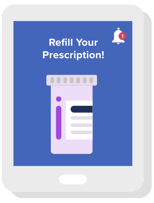

Makes remote patient monitoring possible and easy – This is one benefit that represents a giant leap in managing care. Having the ability to track patient conditions in between visits and notify a clinician or care manager when the patient’s biological data is putting the patient at risk can save lives.


Increases medication reconciliation accuracy, which improves patient safety – It’s unfortunate but true: Many patients do not recall the names and dosages of the medications they are taking. Mobile health can help address this significant health and safety risk.
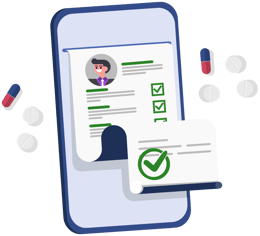

Improves provider communication and coordination – With mobile health technology, healthcare professionals can more easily connect across the health system and with referring physicians and office staff using secure messaging and texting, mobile health record access, and cellular calls. mHealth apps can also be used to alert providers to patients that need attention or that have been admitted to the hospital. Cureatr is improving care transitions using mobile health solutions such as Clinical Event Notifications. The platform makes it easy to see the full picture of a patient, including where they’ve been within the healthcare system, who has treated them and for what, and where they’re going. These notifications allow healthcare providers to do more to coordinate care in transitions across settings.
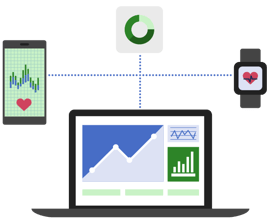
Understanding the benefits of mobile technology is just the first step to seeing the larger picture. In many ways, mobile technology is pushing the industry to a completely new standard of care.
You no doubt have heard the term value-based care. The Centers for Medicare & Medicaid Services states that “value-based care programs reward healthcare providers with incentive payments for the quality of care they give to people with Medicare. These programs are part of our larger quality strategy to reform how healthcare is delivered and paid for.”
The rapid move toward mobile technology in healthcare has fueled three big changes directly aligned with value-based care:
Patients are better engaged in their own care.
As mentioned earlier, mHealth platforms that can help keep people well and out of the hospital are a key component of managing costs and outcomes. In turn, health systems and provider organizations are driven to invest in mobile technologies.
The use of mobile healthcare technologies will become an essential element for health systems and provider organizations that participate in risk-sharing agreements and bundled care initiatives. Under these new reimbursement models, providers are incented to collaborate across specialty and facility lines and care for the patient as a team. This directly aligns with the value-based care model, which not only improves patient outcomes, but also lowers costs that result from reducing unneeded interventions, achieving therapeutic goals, managing medications appropriately, and reducing hospital length of stay and readmission rates.
With the COVID-19 pandemic likely to further accelerate the shift toward value-based care, it’s important to examine the role telemedicine can play in supporting this movement. One way is by extending support and services to rural areas.
Patients who live hundreds of miles or more from the care they need or those who can’t access services promptly may experience poor outcomes. For example, a patient who is prescribed medication for congestive heart failure may not refill a prescription because they aren’t willing or able to travel a long distance to see the cardiologist for a checkup. Or a patient with diabetes may not be willing or able to travel that same distance for regular A1C checks, leading to a dangerous spike in their A1C levels. This, in turn, can lead to increased hospital admissions, readmissions, and overall higher costs.
Telemedicine services can be critical in such circumstances. By enabling remote consultations, in-home monitoring, outsourced diagnostic analysis, remote specialist consultations, and direct to- consumer telemedicine (e.g., virtual consultations for urgent care needs), providers can better meet the needs of rural residents. Let’s examine some case studies where the benefit of these services has been proven.
The adoption of telemedicine in healthcare is surging. An analysis by Grand View Research predicts the global telemedicine market will expand from about $41 billion in 2019 to more than $155 billion by 2025.
Considering the benefits outlined above, this is not surprising. However, numbers alone don’t capture the true impact of telemedicine. Here are some real-life examples of how telemedicine is transforming healthcare:
Littleton Regional Healthcare, Dartmouth-Hitchcock Connected Care
A partnership between New Hampshire’s Littleton Regional Healthcare, Children’s Hospital at Dartmouth-Hitchcock, and Dartmouth-Hitchcock Connected Care will help Littleton Regional deliver neonatal services via telemedicine. The use of teleICN — intensive care neonatology provided through telemedicine — will allow clinicians to provide around-the-clock assessment and treatment recommendations for Littleton babies.
Meridian Health Services
Thanks to telepsychiatry, Indiana patients who used to wait months for an initial appointment with a psychiatrist can now connect with a doctor in just days, reports NPR. Not only are patients embracing this use of telemedicine, but Meridian Health Services, the provider of the telemedicine services highlighted in the article, has been able to grow its team of psychiatric specialists significantly. Mental health services are ripe for management via remote patient monitoring and video visits.
Norton Healthcare
Because of a collaboration with Norton Healthcare, reports WAVE 3 News, students from three Kentucky schools are now benefiting from telemedicine. Through the pilot program, schoolchildren can meet virtually with a Norton provider via a secure video visit made from the schools’ nurses’ offices. The provider can treat common conditions, such as colds, earaches, fever, pinkeye, rash, and sore throat, following a collaborative examination with the school nurse. Rachel Alexander, the telemedicine program coordinator for Norton, told WAVE 3, “We can evaluate the child while at school and allow them to remain in class if possible. We are able to talk with the parents over the phone about the visit and let them know if there are prescriptions at the pharmacy or home treatments for the illness.”
AMITA Health St. Mary’s Hospital Kankakee (Ill.)
Launched a teleneurology program that makes board-certified neurologists available 24 hours a day, every day, to virtually evaluate, treat, and manage the needs of neurological patients. The process, as described by Dr. Kalisha Hill, chief medical officer for AMITA Health St. Mary’s Hospital, in a news release, is simple: “When a patient with neurologic symptoms presents at the hospital, whether by ambulance or walkin — no matter the time of day — the on-call teleneurologist is called for consultation. Using a high-resolution video connection, the teleneurologist performs a neurological examination, discussing any findings and treatment with our on-site clinical team.”
While these use examples are encouraging, and the benefits to patients are obvious, it’s important to be aware that challenges do exist.
Here we identify several research articles on medication adherence and share 10 key lessons learned about patients from these analyses and studies.

It’s clear that telehealth is changing the dynamics of healthcare in very positive ways. Though adoption rates are growing rapidly, obstacles remain to delivering safe, effective patient care to the numerous people who would benefit from virtual services. Here are four of the most substantial telehealth challenges:
Lack of Coverage
The non-standardized coverage of telehealth across states tops the list of issues. In fact, it’s often pointed to as the most significant barrier to telehealth’s further growth and adoption. The fact is that insurance coverage for telehealth services is often inadequate, if not lacking entirely, and inconsistent. A report from the University of Michigan’s Institute for Healthcare Policy notes,
“Currently, telehealth is reimbursed in limited circumstances, and part of that is related to our fee-for-service healthcare environment and incentives around providing care. At the state level, there are many different policies on coverage, which makes the entire reimbursement space very difficult to navigate for the people who are implementing telehealth. From the patient standpoint, this is also very confusing, because one insurance company may pay for a service while another may not.”
The good news is that there have been several positive developments concerning coverage. In April of 2019, the Centers for Medicare & Medicaid Services finalized policies that allowed Medicare Advantage plans to include additional telehealth benefits. Coverage of telehealth was temporarily expanded to help with supporting patients during the pandemic. But there is still significant work to be done in this area.
Confusing Legal Requirements
Again, the issue here is surrounding clarity. For those who want to furnish and get paid for delivering telehealth services, understanding what they need to do (and not do) can be very confusing. To make it worse, mistakes can be costly
A Center for Connected Health Policy (CCHP) report found that
“Remarkably, no two states are alike in how telehealth is treated despite some similarities in the language used. For example, some states have incorporated telehealth-related policies into law, while other states address issues in their Medicaid program guidelines. In some cases, CCHP discovered policy inconsistencies within a single state. This variability creates a confusing environment for those who use (or intend to use) telehealth, especially health systems that provide healthcare services in several states.”
Failing to follow laws has ramifications, as Blue Cross Blue Shield found when it was fined $125,000 by North Dakota state officials for telehealth coverage violations, reports mHealth Intelligence.
In a Medical Economics article, Dr. Neal Sikka, chief of the innovative practice and telemedicine section at the George Washington University Medical Faculty Associates, offers the following advice for physicians considering adding telehealth services to their practices:
“You do have to be careful. You can be successful if you’re meticulous, use good resources, have risk managers looking at policies and procedures, and have good technology selection, appropriate documentation and training around telemedicine.”
Failing to follow laws has ramifications, as Blue Cross Blue Shield found when it was fined $125,000 by North Dakota state officials for telehealth coverage violations, reports mHealth Intelligence.
Lack of Uniform Accessibility and Affordability
Even now, large parts of the country lack the internet speeds required for the delivery of efficient telehealth services.
As one NPR survey found,
“One in five rural adults say accessing high-speed internet is a problem for their family, and without reliable, broadband (high-speed) internet access, rural communities are unable to participate in the digital economy, creating a major divide between rural and urban areas.”
In addition, gaining access to broadband to just a piece of the puzzle. If patients cannot afford the cost of broadband, they may lose the ability to use telehealth services. A report from BroadbandNow, a data aggregation company focused on internet options, found that,
“Roughly 146 million people in the United States (about 45% of the population) do not have access to a low-priced plan for residential wired broadband.”
Only when all people have equal access to internet services can the true benefits be realized.
Challenges of Interoperability
Perhaps one of the most vexing problems is that healthcare technology is often lacking interoperability.
The rapid proliferation of telehealth has, in part, created this challenge, and there’s no easy solution. As an mHealth Intelligence report notes,
“... telehealth interoperability is currently mired in competing interests — between pay-for-service and pay-for-value, consumers and providers, and clinical interests and business cases. It’s siloed in departments and programs that have proven telehealth’s value but haven’t been scaled out to the enterprise or embraced by the entire health system. And it’s been stymied by parties who see value in data but not in sharing it.”
Compounding this big problem are other barriers, including privacy and security, technical support, and patient preference. Organizations that want to offer telehealth services must be very selective about how they will provide the technical support required when issues crop up and choose technology partners carefully.
Though these kinds of choices about technology partners are in your control, other choices are not, such as what type of smartphone patients decide to use — or if they are equipped with one at all.
Smartphones are by far the most popular form of mobile health devices. The Pew Research Center notes that more than 80% of American adults own a smartphone while the percentage of U.S. adults with a tablet hovers around 50%. Still, not everyone owns a smartphone.
While we believe the pros of smartphones in healthcare outweigh the cons, there are some shortcomings that organizations and clinicians will want to take into consideration when developing and growing a mobile health strategy.
Let’s be honest: Not all smartphones are created equal. Some are much more expensive and unaffordable to many. Others just don’t age that well. In addition, most apps on smartphones require Internet access to function to their full capacity, which cannot always be assured. Furthermore, a lot of healthcare apps aren’t available on all types of smartphone devices. Data privacy concerns can further complicate adoption. If a smartphone is lost or stolen and lacks proper levels of security, the information stored on it and accessible via apps can be viewed and possibly downloaded. Such a scenario could have significant legal and financial implications for an organization and clinician.
Other practical health considerations exist. For example, smartphones can be quite dirty. Think about all of the places you have used, placed, and dropped your smartphone. Unfortunately, healthcare workers have used, placed, and dropped their smartphones in many of the same places as you. And while one might hope that healthcare workers, mindful of the dangers of bacteria and infections, would keep their smartphones as sterile as possible, that’s often far from the case.
Also, the human element — one of the most difficult factors — must be overcome with some patients. Some adults who would benefit from using a digital health tool are increasingly reluctant to share data with entities like providers and insurance companies.
Still, many patients are simply not yet on board with viewing their medical data on smartphones, notes an EHR Intelligence article covering a JAMA Network Open study. The study’s results showed that less than 1% of patients who logged into their health system’s patient portal also used their smartphones to view their EHR data.
Until these barriers to adoption are adequately addressed, clinicians cannot engage with all patients using smartphones. And even once those are addressed, we must always keep in mind that problems and hurdles are inherent to any technology.
Organizations that want to offer telehealth services must consider how they will provide the technical support required when issues crop up. A report from the American Institute of Healthcare Compliance notes,
“... in the excitement of developing telehealth programs, organizations should not lose sight of privacy and security regulations that apply to these new services. After all, protected health information under HIPAA can include data that is transmitted during the provision of telehealth services.”
While much of the pushback against telehealth tends to come from older patients who are uncomfortable with technology, patients may simply prefer in-person visits over a virtual experience or have lingering concerns about security. However, the onset of the COVID-19 pandemic has given some of these people a reason to rethink their hesitations.

There are few silver linings of the COVID-19 pandemic. But perhaps one area where this health crisis has had a positive effect is in the field of telemedicine — even if that has been out of pure necessity.
To help support physical distancing and permit high-risk and other patients who want to reduce the risk of contact with other individuals, a rapidly growing number of providers nationwide have turned to telemedicine as a safe, efficient, and effective way to deliver a wide array of healthcare services to patients.
Telemedicine is in the spotlight as it is helping to provide safe care, but there’s more to that story. Patients are finding that they appreciate the service and overall experience of receiving virtual services. Here are five examples of healthcare services organizations are currently providing via telemedicine during the pandemic:
We anticipated that telemedicine and telehealth would continue to experience gradual increases in usage. What we did not anticipate was COVID-19 and how the pandemic would seemingly transition telemedicine and telehealth from “nice-to-have” services to “must-have” services. Let’s examine some of the ways thought leaders believe COVID-19 has likely affected the future of telemedicine and telehealth.
We think it’s helpful to look at these terms using the summary provided on the HealthIT.gov website: “Telehealth is different from telemedicine because it refers to a broader scope of remote healthcare services than telemedicine. While telemedicine refers specifically to remote clinical services, telehealth can refer to remote non-clinical services, such as provider training, administrative meetings, and continuing medical education, in addition to clinical services.”
The Centers for Disease Control and Prevention notes that,
“Often, telehealth is used interchangeably with the terms telemedicine or eHealth. Telehealth, however, is broader than these other terms; telemedicine and eHealth are distinct areas within telehealth.”
With so much ambiguity concerning the differences between telemedicine and telehealth, our advice is as follows: When discussing telemedicine and telehealth (and we can expect these topics to come up a lot more going forward), ensure those on the receiving end of your information understand what you are referring to — whether you are distinguishing between the terms and how or whether you are using them interchangeably. This will help avoid confusion and better ensure productive discussions.
Why is this important? Consider how COVID-19 will drive increased adoption of telehealth services; these surveys indicate patients’ willingness to embrace this change.

52% of seniors are comfortable using telehealth services to receive care.

91% reported a favorable experience and 78% rindicated a likelihood to complete a medical appointment via telehealth again.
At Cureatr, we are optimistic and excited about the future of telemedicine and telehealth. In fact, we were bullish on remote healthcare even before COVID-19. Now that there’s a greater force for accelerating the embracing of these solutions, there will be growing recognition of the critical role telemedicine and telehealth should and will play in meeting the healthcare needs of patients now and in the future.
Just as telehealth and telemedicine will play a greater role in the age of COVID-19, so will telepharmacy. To review, telepharmacy is defined by the Medicina journal as “... a form of pharmaceutical care in which pharmacists and patients are not in the same place and can interact using information and communication technology facilities. Telepharmacy has been adopted to provide pharmaceutical services to underserved areas and to address the problem of pharmacist shortage.” Like most other telehealth services, telepharmacy is receiving greater attention during the pandemic.
Here are six noteworthy telepharmacy developments and announcements pertaining to the coronavirus pandemic:
Telepharmacy has demonstrated value in medication selection, order review, and dispensing; sterile admixture verification; patient counseling and monitoring; and the provision of clinical services. Essential to maximizing such benefits is easing telepharmacy restrictions, writes James Broughel, a senior research fellow at the Mercatus Center at George Mason University. “Currently, most tests for COVID-19 have a relatively long turnaround time, often requiring patients to wait at home for results. When results become available, tested individuals could have a consultation with the pharmacist on the phone or via video conferencing platforms such as Skype or Zoom.”
The American Pharmacists Association (APhA) reports that the CDC recommends that “Pharmacists who are providing patients with chronic disease management services, medication management services, and other services that do not require face-to-face encounters should make every effort to use telephone, telehealth, or telepharmacy strategies.”
As U.S. Pharmacist notes, a growing number of states issued waivers or otherwise amended regulations to permit the use of telepharmacy for management of a wide range of pharmacy operations.
A dozen pharmacy organizations representing the interests of U.S. pharmacists released a joint set of policy recommendations concerning the COVID-19 pandemic. One of the four main policy areas addressed in the recommendations concerned the need to “ease operational barriers to address workforce and workflow issues.
The National Association of Chain Drug Stores pushed for “Immediate federal policymaking [that] would empower pharmacies and pharmacists to help enhance the nation’s COVID-19 response right now...” Among their recommendations: “enabling telepharmacy.”
In late March, the Mercatus Center issued a series of policy proposals it believed could contribute to a “quick, entrepreneur-led rebound” of the U.S. economy. One such policy concerns expanding pharmacist practice authority to improve healthcare efficiency.
It’s clear that the effective implementation of telepharmacy relies on policy change. Let’s review where the laws stand as of today.
Concurrent with federal and state governments ramping up their efforts to combat the spread of COVID-19, legal and regulatory developments concerning telehealth have begun to evolve. These developments are generally aimed at helping ensure patients can remain at home without jeopardizing their access to critical services. However, many of these changes have neglected to include a critical resource that can help in the battle against COVID-19: pharmacists.
If you are thinking about launching a telepharmacy program or growing an existing one, these are some of the key takeaways from telehealth law changes. The American Society of Health-System Pharmacists (ASHP) states that its understanding was that while pharmacists can provide telehealth services “incident to” a Medicare-eligible provider, they cannot yet directly bill Medicare for these services. Unfortunately, this is a missed opportunity to provide further resources in the fight against COVID-19.
Why is this so important? Granting provider status to pharmacists and the consequent ability to bill the federal government (i.e., CMS) and commercial payers would allow pharmacists to play an even greater role in the effort to end or at least better contain the pandemic. It’s even more necessary at a time when the country has an overstretched workforce and an oversupply of pharmacists.
The aforementioned joint policy statement issued by 12 pharmacy organizations advocates that pharmacists should be utilized as frontline responders for COVID-19 patient care. The statement notes that “Pharmacists are the most accessible healthcare providers and the first touchpoint of patient engagement with the healthcare system. ... Pharmacists are trained to treat infectious diseases and can significantly expand access to care, if barriers are removed.”
The statement goes on to discuss that pharmacists can help with COVID-19 response by “... administering tests, treating COVID-19 when treatments become available, and by testing for and treating influenza and strep throat infections... [to] alleviate some of the burden on hospitals and clinics so they can focus on high-risk COVID-19 patients.”
These pharmacy organizations are urging legal and regulatory authorities to implement the following recommendations:
Approve additional pharmacist-provided services.
Address workforce and workflow issues that prevent full and effective pharmacist engagement in the COVID-19 response.
Remove barriers for pharmacists to provide viable alternatives if a particular medication’s supply chain is interrupted.
Remove reimbursement barriers that prevent pharmacists from fully and effectively engaging in COVID-19 response.
Only with continued advocacy and lobbying for including pharmacists and their services into future telehealth-related legislation will lawmakers be motivated to address what we consider a grave oversight. The impact of changes can have far-reaching effects and benefits, considering the impact on medication management, as discussed below.
In April 2020, we compiled a list of some of the top reports concerning medication management and the COVID-19 pandemic. Here are a few of the published news reports which demonstrate the urgent need for policy change:
Though CMM is nothing new, its impact is now gaining more attention. With CMM powered by Meds 360°, pharmacists have the easiest, most user-friendly way to determine, in real time, a patient’s current medications across all prescribers and care settings.
Many companies are offering complimentary solutions and services to support frontline workers in their efforts to deliver high-quality patient care in the midst of the COVID-19 crisis. Cureatr is one such company and has been offering the Meds 360° medication management software solution on an open access basis to qualified healthcare providers on the front lines of the COVID-19 fight.
We aren’t alone in stepping up to fill the need. Consider the example these other three companies are setting for the industry:
Cureatr has also been offering a free patient population assessment to help organizations identify patients at risk of developing serious illness due to COVID-19 based on their medication profile and demographics. This offer is our way of trying to help alleviate some of the strain on the U.S. healthcare system during the pandemic. As our CEO Richard Resnick said, “We are contributing our team and technology to this effort to increase capacity and throughput so any American who needs urgent healthcare will be able to receive it.”
This ebook has covered a wide range of important and timely issues concerning the emergence of telehealth, growing importance of telepharmacy, how telehealth and telepharmacy are making a significant impact on medication management, and the short- and likely long-term effects of the COVID-19 pandemic on telehealth and medication management. The health crisis has placed a significant strain on our healthcare system and challenged clinicians and patients in ways most have never experienced. Fortunately, telehealth has emerged as a vital and timely solution. It has helped support the delivery of critical medication management servicxes that have kept patients safer and healthier while easing the burden on providers striving to keep their patients well.
Before the pandemic, incorporating telehealth into a medication management program would probably have been a recommendation or a suggestion of something to consider down the road. Now, one can argue that it’s become a necessity. Adding telehealth is not without its challenges but doing so has become much easier thanks to the easing of restrictions and, perhaps more importantly, the embrace of the solution by users. As a column in The National Law Review notes, “Telehealth is the new normal and there is no turning back,” now that patients and providers recognize that telehealth can effectively and safely replace in-person visits for many situations.
Telehealth and the disciplines within it, including telepharmacy, are reshaping healthcare and likely to continue doing so for years to come. It is imperative that organizations identify how telehealth can further support their existing medication management programs and be leveraged to address shortcomings and achieve efficiencies. Improving medication management via telehealth and telepharmacy will help reduce medication errors, improve patient safety, support better outcomes, and much more — all of which will translate into healthier patients and an overall healthier healthcare system.
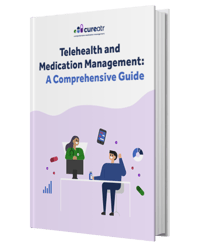
© Cureatr 2023 | Privacy Policy
HEDIS® is a registered trademark of the National Committee for Quality Assurance (NCQA).